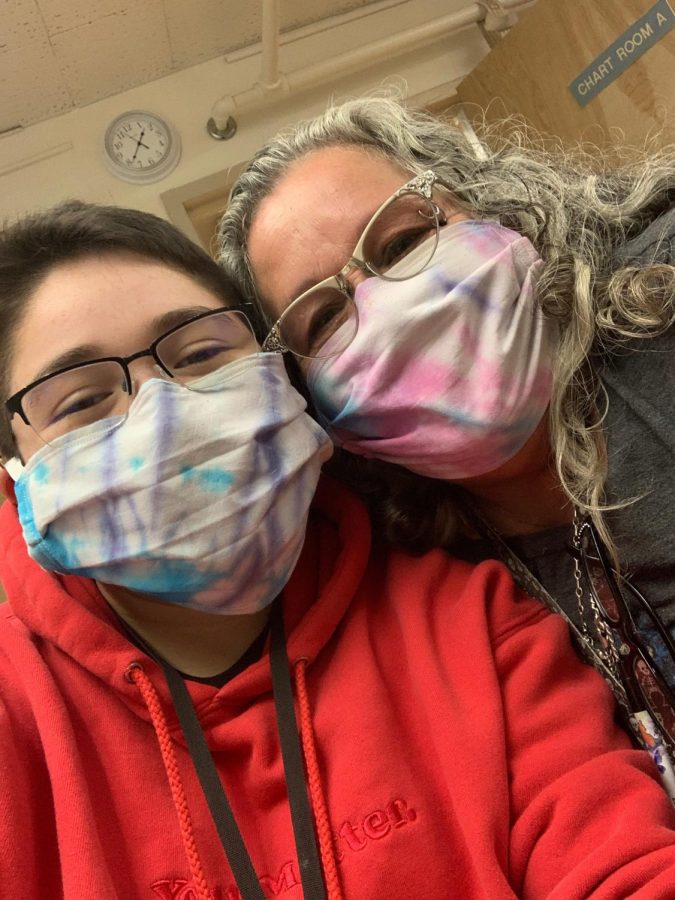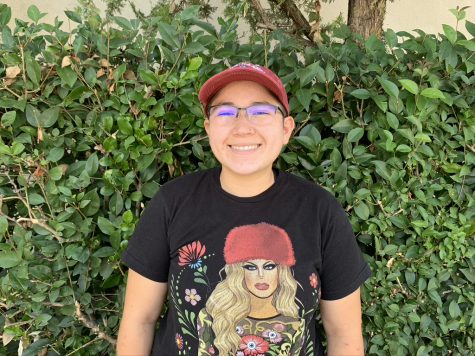It’s 6 a.m. and the sun is still not up. I gather my glasses, car keys, work keys and I’m on my way out. I can’t forget my mask. I make my 30-minute commute to Novato where I work. I can’t forget my mask. I open the door, head to the back for my temperature check. I start making my way onto the floor. I can’t forget my mask.
Working during the pandemic has had its benefits and challenges. There’s a feeling of normalcy when I walk into work on Fridays to start my work week. It’s the first time I wear something other than sweatpants and the first time I’ve left my house since Monday.
Having already worked in a residential psych facility for several years, there’s not much there I’m uncomfortable with. I’ve gotten used to the challenges, such as calming a difficult client or reality checking someone stuck in their delusions, and the more relaxed experiences like catching up with clients and discussing scheduled activities. I’ve also gotten used to my coworkers and the clients themselves. Work is my opportunity to interact with people other than my family at home.
As I make my way around the facility recording more than 75 people’s temperatures, I stop to talk to a client here and there. I get them what they ask for, such as towels, toothbrushes or shampoo, after logging their temp and move onto the next. Nothing feels weird yet; it’s another census for me where I record all client’s whereabouts, until my glasses start fogging up and I’m reminded of the cotton mask covering my face. The mask serves as a reminder that we’re in the middle of a global pandemic and work and life are not normal.
Over the next eight hours, the only time I get a break from the mask is when I’m in the chartroom chatting with coworkers. Those annoying fluorescent lights and small work areas I used to walk around to avoid have now become one of my retreats. An area where I can speak without sounding muffled. An area where I can clearly read and see faces without my glasses fogging up. An area where I can wipe away the sweat from my face mask.
Working in a pandemic brings added responsibilities. The shelter-in-place order isn’t just about keeping myself and my loved ones safe. It’s also about keeping the clients we care for safe as well. If I decided to break the order, I would not only endanger my immediate circle but the clients, my coworkers and their families as well.
As isolated as this pandemic makes me feel, I know I’m not the only one here experiencing these new anxieties.
Michelle Juarez, who is an LPT, or licensed psych tech, took two-and-a-half weeks off when the shelter-in-place order began due to fear of bringing something to her family. Juarez explained that in the beginning she had more fear due to frequent new information about the virus. This fear around staff and clients prompted her to take that time off.
Juarez, one of the main shift leaders on the p.m. shift, returned after realizing that work might be one of safest places to be as long as our coworkers are doing what they’re supposed to be doing. The clients no longer visit family and friends on pass, are not approved to leave the facility, and visitors and other outsiders are not allowed into the facility. The only contact with the outside world is our coworkers.
“There’s a lot of trust needed with each other right now. Trust that we’re all following the shelter in place order,” Juarez said.
The masks were a weird thing to navigate at first. Before they became mandatory, a coworker handed out 12 homemade masks from her mother-in-law. I remember thinking to myself: “Is this overkill?”
Less than a week later, the administration required us to wear facial coverings. Administrators handed out two paper masks with a paper bag and staff were told to rotate the two, keeping one within your car to let the sun’s heat “sanitize” the masks.
Maria Herrera, who is an MHW, or mental health worker, was not pleased with the new policy and believes we should have access to more masks. Like many others in similar circumstances, Herrera is concerned about the safety of reusing these masks. “I’m angry with this facility. It’s not right what they’re doing. Two masks given, being told to keep one in your car. It’s not right!”
Suddenly, having access to washable masks did not feel like overkill.
Herrera is also one of the many workers facing financial hardship during this pandemic. Being employed while unemployment rates were rising highlights how beneficial it is to work in the healthcare field. It’s always going to be essential service, but just because we are working, it doesn’t mean those around us are as well.
Herrera had to pay her newly unemployed roommate’s share of rent on top of her own. Her roommate will not get a stimulus check because of her immigration status.
“She’s out of money, and it’s not her fault,” Herrera said. “It wouldn’t be right to put her out on the street. I wouldn’t do that.” Herrera was working several jobs before the pandemic began and is currently working up preschool lesson plans from home, making sure she is ready to start and still has the necessary funds when this is over.
Margie Balmoja, who is an LVN, or licensed vocational nurse, also works multiple jobs. She works at another residential care facility, where she faces a unique risk. One of their clients has tested positive and the entire facility is in quarantine. She was mandated to report exposure to our nursing director. She wears an R4 N95 mask with a paper mask on top and is required to get tested every two weeks.
Balmoja practices social distancing at home as well to protect her children and elderly mother. She also wears a mask at home around her kids. She feels less fear being at this facility as long as she washes her hands. “It’s scarier and more severe when a client tests positive versus staff testing positive because a staff member can go home and isolate themselves, but a client stays within this facility, creating more chances of spread,” Balmoja said.
For a few of the clients, it was unsettling seeing employees sporting these new accessories. One client accused us of pumping poisonous gas into the facility and wearing the mask as personal protection from it. Catering to others while wearing a mask is difficult enough, but then add in the paranoia, confusion and delusions that come with a mental illness.
Several clients couldn’t handle all of the rapid changes around them as administration worked to instill pandemic protections including staff in masks. Watching the news in the day room and seeing the pandemic unfold into their lives are two different things.
They struggled with several of the new measures put in place, which include plexiglass screens at dining room tables and the medication room window and 6-foot spacing for all lines. Red tape marks where they’re supposed to stand, making long lines seem longer. Even staff wondered about the effectiveness of implementing these measures since the clients all live together and interact in other spaces within the facility, where social distancing measures are not in place.
Natacha Wiebusch, LPT, said she’s not worried and agrees that we’ve gotten stricter, but it’s redundant. “It’s all for looks,” she said. “We’re the ones who have to protect the clients by going home and not interacting with others.”
Cannessa Davis, LVN, said many clients could decompensate, or lose mental stability, without family visits. Davis described these clients as “hardy” for the most part, but the psych meds comprise their immune system as well as adding other health implications.
She’s comfortable with the confinement because it provides the highest level of safety, but expressed anxiety when thinking about them going out on day passes after the shelter-in-place order is lifted. She worries they won’t have the judgment to practice social distancing.
“I think it’s going to be scary for quite a while,” Davis said.
The shelter-in-place order has been wearing on the clients and staff equally. Jeremy Verde, LVN, described it as stressful and exhausting. “I’m pretty over being in this quarantine, but I’m still cautious. I worry about my family,” he said.
When not at work passing out medications, he’s been spending his time playing Pokémon Go and watching gaming videos, but he’s used to going fishing or mountain biking frequently.
The mask-wearing has affected Valencia Davis, LPT and no relation to Canessa Davis, on a health level. She has asthma and the masks make it even harder to breathe, but she’s determined to keep the clients and her elderly parents at home safe. “I’m willing to make the sacrifice that when these clients see me they feel secure that I’m doing the best to keep them safe,” Davis said.
While holding onto my job and having money to pay my bills has been beneficial, it’s also been draining. I have to admit I didn’t go out much before the shelter-in-place order, so when I’m at home with three kids, I forget about the chaos in the world. When I walk back into work, I’m reminded of it all.
Mitch Geis, from occupational rehab, describes the mental attitude as feeling fatigued. A psychological and emotional fatigue and we’ve had to modify our take on self care. Geis says he feels tired and burnt out, especially with a suspension on time off at his other facility, meaning he couldn’t take a few days off even if he wanted to.
In the midst of all this negative news, he said, it can be easy to forget the positive.
“I’m proud of my team and the work we are doing,” he said. “There’s a sense of pride because mental health is on the frontline despite not being considered as such.”
This pandemic has been draining but I’m happy to keep working. I’ll continue enjoying my days of escapism at home with kids. This pandemic has definitely taken its toll on our facility. At one point, we had a registered nurse quit and walk out because he felt we were not taking the necessary precautions to keep staff safe. However, I hold the idea of work being one of the safest places to be during this nonsense.
I’ll continue to wear the mask that fogs my glasses, but keeps our clients safe. And hopefully soon, I’ll celebrate the day when I can forget my mask.




